The Bee's Water Dance
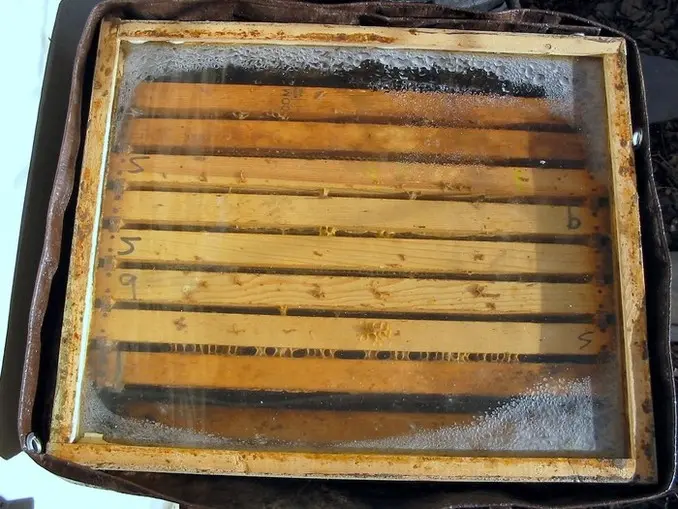
Hey there! ❄️ Let’s chat about the fascinating world of beehive condensation during a winter in Wyoming. I got cozy with the concept by placing a plexiglass inner cover on a hive.
Curious about what I found? Dive in:
- Blessing of Dry Climate: In our dry Wyoming climate, a water-filled division board feeder proved to be a real blessing.
- Liquid Gold for Bees: Condensation is like liquid gold for a thriving hive.
- Winter’s Minimal Condensation: Surprisingly, winter hive condensation is minimal.
- Spring Condensation Bonanza: Spring, on the other hand, brings a condensation bonanza.
- Spring Boost: Late winter and early spring condensation act as a catalyst for colony expansion.
- Peak in Spring: The peak condensation occurs in early spring, coinciding with the bees gearing up for brood rearing.
- Summer Sip: Interestingly, there’s little summer condensation, and whatever forms is quickly slurped up by the busy bees.
- Fall Reflection: Fall condensation mirrors the late winter pattern.
- Clever Bees: No worries about condensation dripping on the cluster; the bees have it all figured out.
- Natural Comb Advantage: Bees with natural comb consume less water.
- Global Insights: Similar observations were made in England, which has a more humid climate.
Now, let me share the details of this intriguing test.
The Experiment
Plex Cover
To peek into the world of condensation without disturbing our buzzing friends, I crafted a plexiglass inner cover. Then, I placed a beehive with this transparent cover, along with a migratory lid, right next to my cozy abode.
Thirsty Wyoming Climate
Wyoming, with its long, windy winters and sporadic water sources, isn’t exactly a hydration paradise.
- Icy Winters: Winter is icy and cold.
- Unpredictable Spring: Spring is unpredictable.
- Scorching Summers: Summers are scorching, but water sources are scarce.
Early spring offers a lifeline with melting snow banks, but it’s a risky affair with rapidly changing weather.
Once the snow banks melt, we rely on irrigation for consistent water. However, once the irrigation ditches are turned off in late fall, water becomes a precious commodity.
In-Hive Water Supply
When the hive warms up and melts the frozen condensation on the plex, the bees eagerly lap it up. It disappears within hours. They’re sipping on in-hive water even when their external water sources are frozen solid. So, here’s what I did:
- I added a division board feeder inside.
- Placed a wooden float in it.
- Filled it with water.
- Positioned it on the warm side of the hive.
“But won’t they drown?” you ask. Not at all.
- The hive quickly caught on to the water availability.
- They happily used it.
- Water levels dropped about an inch per day.
- By spring’s end, this hive was as robust as any of my hives.
- It kickstarted brood rearing earlier.
- Bee population remained stable despite unpredictable spring weather.
- These savvy bees completely ignored their outside water source.
- They continued sipping from the feeder during bad weather and at night.
During a decent honey flow, the division board water is left untouched:
- It could turn into a septic disaster.
- Required occasional dumping, not the most pleasant task.
Bye-Bye Internal Feeder
Once I removed the feeder:
- At 5 minutes, bees were on a frantic quest for the water source.
- At 15 minutes, panic set in; most hive activities halted.
- Bees ran amok inside and around the entrance.
- They eventually rediscovered the forgotten outside water source.
- Within 30 minutes, a bee brigade was ferrying water into the hive.
- It was a frenzied activity, like a mini honey-robbing scene.
This frenzied water-gathering continued for 3 hours after the water-filled feeder returned inside.
After that, outside water activity returned to normal, with just a few bees fetching water. Yet, they never abandoned their outside water source.
Observations
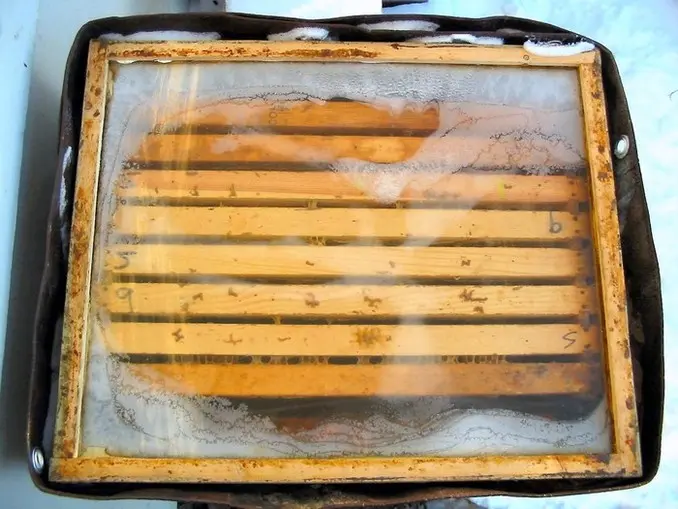
- At -10F, condensation is ice, but no bees.

- At 10F, condensation is frozen, but feeder water is liquid. No bees.
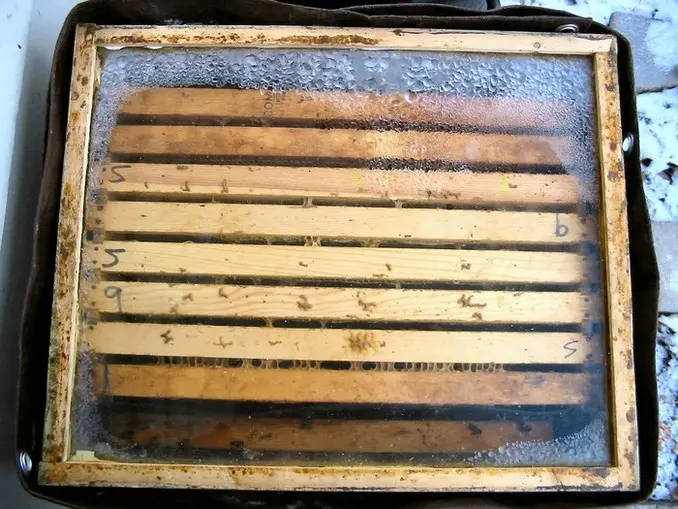
- At -20F, condensation is frozen, and only a few bees are at the feeder.
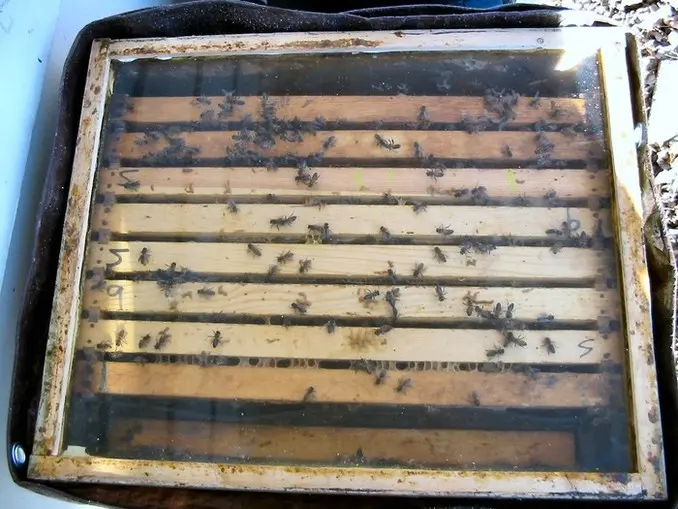
- At -30F, minimal condensation; bees are both at the condensation and the feeder.
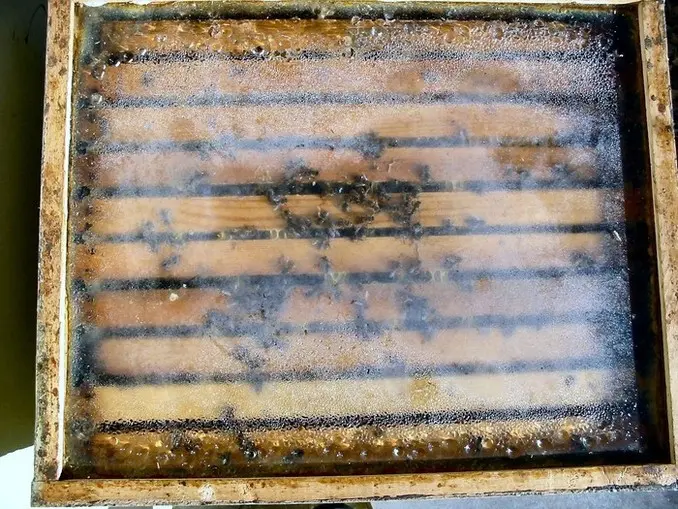
- At -40F, maximum condensation.
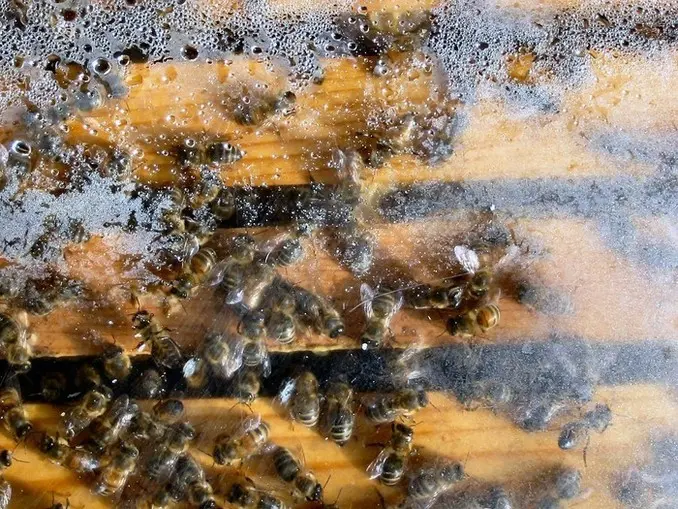
- At -40F, more bees are licking up condensation as the cluster breaks.
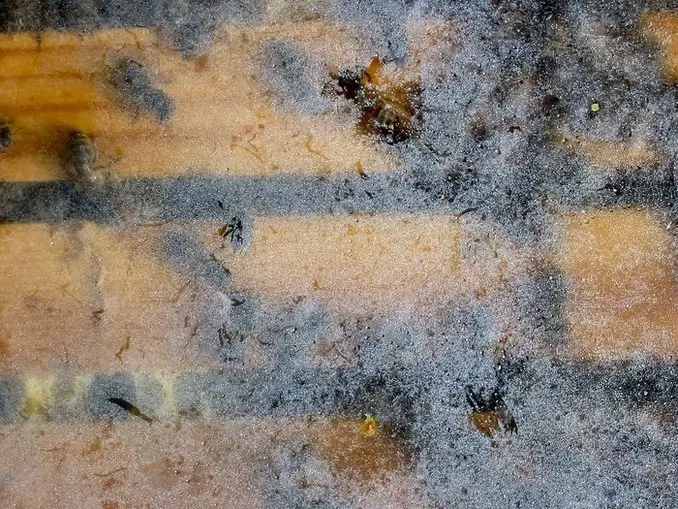
- At -40F, bees start harvesting condensation.
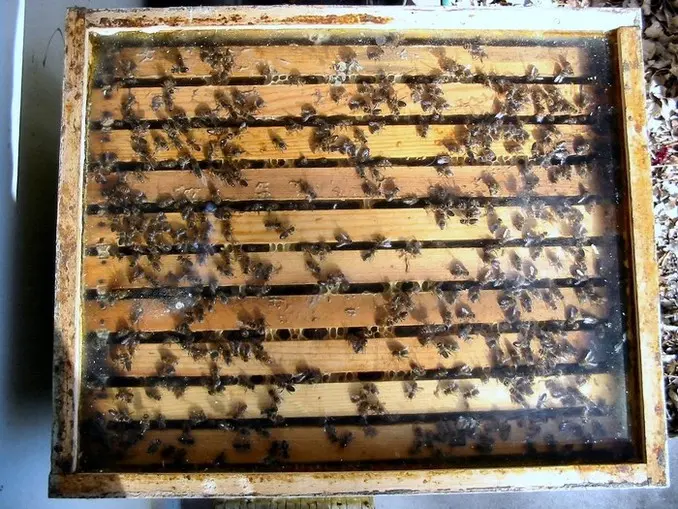
- At -40F, condensation is harvested, and bees are working the feeder.
These observations were so intriguing that I monitored the plex hive with its internal water source for four years. This hive comprised three deep supers with 3/4″ holes drilled in the upper corner of each super.
Late Winter - Early Spring
Once the internal hive temperature warmed enough to prevent the feeder water from freezing, the bees consistently consumed it. Around 30 degrees outside, even when clustered, the bees sent out an expedition to fetch water from the feeder. They also consumed condensation on the plex, acting like a shot of energy for them, much like feeding thin sugar syrup.
The most significant condensation occurred during spring when brood rearing was in full swing. As the bees clustered, abundant moisture was released when the cluster broke, forming large water drops across the full extent of the plex. This extra moisture was swiftly consumed within a few hours.
Top ventilation significantly reduced this condensation. It’s a costly loss of clean, warm water that must be replaced by cold, hard-to-forage water from outside the hive.
Summer
Only a small amount of condensation was observed during summer. Tiny droplets would form around the outer edges of the plex cover before sunrise, quickly consumed by the industrious bees. Some additional condensation occurred directly above the feeder.
Fall
Water consumption mirrored brood rearing. As brood rearing decreased in October, so did water consumption. Fall condensation mirrored spring, but the overall amounts were slightly less.
Open vent holes almost completely eliminated the minimal moisture condensation that occurred in the fall.
Winter
For winter:
- The 3/8″ hive entrance was reduced to one-third of its length.
- A wind baffle was inserted to block Wyoming’s gusty winds.
- The hive was wrapped in a single brown plastic tarp for extra wind protection.
- All vent holes were plugged.
Winter condensation wasn’t a threat; it was a resource!:
- It never dripped on the cluster.
- The area directly above the cluster remained condensation-free.
During winter, the bees form a tight cluster, tightly controlling water loss. It’s no surprise there’s minimal winter condensation.
- Honey consumption is minimal.
- Brood rearing is almost nonexistent.
- Cluster temperatures are at their lowest.
Water in the feeder remained liquid when outside temperatures fluctuated around 20 F. When temps consistently dropped below 20 F, the water would freeze. Then the bees stopped working the feeder and plex cover for moisture.
By late December, water levels and condensation remained unchanged for weeks.
However, when the weather warmed enough to melt ice in the feeder, the bees would rapidly consume available water, causing a significant drop in the feeder’s water level. Sometimes the level would decrease by 4 inches in 24 hours. Initially, a leaky feeder was suspected, but that wasn’t the case. When the bees needed a drink, they came to the feeder and got one.
Opening or closing the vent holes had no effect on the plex’s winter condensation. The feeder’s presence made no difference in the amount of winter condensation on the plex cover.
Discolored Top Bar Ends
I’ve used the discoloration of top bar ends as an indicator of excessive winter moisture, but it turns out it’s a poor one. A thirsty hive can have discolored top bar ends even without much condensation.
Air rises above the cluster to the hive’s top, cools, and then flows down along the exterior portions of the hive. Eventually, condensation occurs. If the temperature is low enough, the moisture forms ice. In my climate, ice only formed against the hive’s exterior portions and never directly above the cluster.
In spring, black mildew was found on the top bar ends, indicating that moisture sat in the frame rest area even when no moisture was directly above the cluster.
Natural Comb-Sized Bees Are Different
Bees with natural comb consume water differently than their larger-cell counterparts from spring through fall. However, winter consumption is distinct. They work on condensation but pay little attention to feeders. They haven’t taken that big drink like the large-cell bees.
It seems:
- They get all the moisture they need from condensation.
- Maybe natural comb bees need less water during winter.
- Perhaps the closer comb spacing is less drafty.
Results
Water - Ventilation Management
I tweaked my water management practices for conventional foundation-based hives:
- Provided internal water from December through May.
- Eliminated all upper ventilation during winter without adverse effects.
- A healthy, normal-sized cluster didn’t suffer from winter moisture.
Very small clusters in a cold place can get wet. I overwintered five-frame nucs in a stack. One nuc, with a small cluster, got too wet. It was located on the north side, at the bottom of the pile, and mold grew on the cover. The nuc survived but was clearly damaged by excessive moisture.
Hives that dwindle due to disease, parasites, or poor nutrition can suffer from excessive moisture, but it’s symptomatic of other problems.
I’ve overwintered hives outdoors in interior Alaska where temperatures didn’t climb above 0 F for months, and extreme temperatures approached -70 F for weeks. Clear rim ice would form inches away from the cluster, and hoar frost would fill up the rest of the box. Yet, these hives didn’t succumb to excessive moisture when they were healthy and had enough food.
Musings
Bees in a natural cavity wouldn’t have much top ventilation. If they were in a tree, most insulation is above and below the cluster. If the entrance were at the cavity’s bottom, airflow would rise above the cluster and descend along the nest’s outer margins. Most condensation would occur in those outer margins. It wouldn’t drip on the cluster but would provide a ready source of scarce, winter water.
Water might be absorbed by the wood in the nest cavity, acting like a sponge and functioning like the feeder in my hive.
A water source inside the hive would moderate the need to forage under marginal conditions. Broodnest humidity could be more easily maintained, and granulated honey could be used before outside water sources are available.
As outside conditions improve, the natural moisture flow is down the sides and out. That would follow the natural airflow direction, enhancing cavity drying.
A lack of moisture often becomes a problem with bees wintering indoors. When inlet air temperatures are low, and airflow rates are reduced, they become dry. Rather
The Right Atmosphere Matters – Maybe
My sweet hives call a dry, breezy home theirs. Snow only plays hide-and-seek with their entrances for a few weeks. The skies? Clear and sunny, the perfect backdrop for winter bee ballet. They take a breather from their cozy cluster about once every three weeks, reaching for a winter canteen.
Now, let’s talk about a different scene – a place where hives wear icy coats, and clouds paint the sky gray all day. The water game might be a plot twist there. But guess what? Even in those chilly conditions, the bees play it smart, sealing the upper hive zones. Maybe in such scenarios, bees crave an umbrella, not just a canteen.
A Tale from England
Dave Cushman, an English bee whisperer, dropped me a note. Here’s the scoop:
I played around with glass tops and a sprinkle of plastic ones. What I spotted was a dry circle in the middle, and cute spherical drops around to the corners.
The central circle had its dance, shifting a bit (our colonies don’t hug the smaller boxes completely). The droplets? They played peek-a-boo and got tinier toward the corners. . .
Best Buzzes & 73s, Dave Cushman… G8MZY
Make sure to hop over to Dave’s Spot.
Your Hive’s Hangout
Now, let’s chat about your hive’s hangout. Sadly, figuring out what your buzzing buddies need means doing some detective work.
- Tossing a plex cover on the scene? Brilliant move.
- Thinking lexan? Budget-friendly but not as tough as plexiglass.
- How about a cut-to-size plastic sheet? DIY scenic view, anyone?
Keep an eye on your bees, spill the tea to fellow bee enthusiasts, and share your findings on a bee list. Trust me, enough observations will turn hive hydration and ventilation into a well-read story. My bet? Winter thirst might outshine winter condensation. ✨
-Cheers, D 🐝🤠
